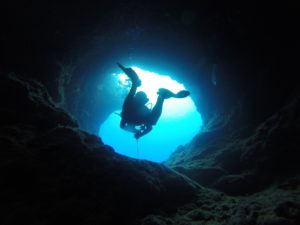If you’re a caver and have run into some bodies of water during a couple of your trips, you probably asked yourself “What if I jump in there?” at least once. Even more so if the water seems quite deep and leads elsewhere.
Well, as it turns out, you actually can jump in! But not just as is while in the middle of your exploration trip, oh no. See, there is this activity called cave diving, which, as the name implies, means that you can go diving in a cave.
Cave diving is considered as an extreme sport, so if you want to do this as a recreational activity you can’t just jump in and swim in the first body of water you see underground, at least not without adequate preparation.
What is cave diving?
As mentioned earlier, cave diving is an extreme sport where, to put it shortly, you dive into bodies of water that you see inside caves. Obviously, the technicalities go much deeper than that (pun intended), but for a basic understanding, this is how it is.
For the types of people who go cave diving, there are the cavers who enjoy the thrill of exploration and want to explore as much as they can. There are also those who dive to explore flooded caves for scientific investigations. Finally, for those who are at great risk underwater, people utilize cave diving to search for and recover lost divers.
As it is an extreme sport, this means that one must be fully aware of the type of danger that cave diving can bring. In fact, cave diving should never be attempted by anyone with little to no open-water diving skills. You need actual diving experience first before you can actually consider specialized cave diving, in which case you might be able to do training and equipment procedures that are required for such a sport.
In terms of equipment, the basic idea of cave diving equipment is the same as that of open-water diving equipment: to help keep the diver safe while swimming, but cave diving gear is very specialized for the environment it is in, and you will have to learn how to utilize it properly. For instance, open-water diving will have you drop your weights in case of an emergency where you will need to surface immediately. This is not something you can do in cave diving, due to the ceiling likely covering the top of the water. If you were to drop your weights, you may very well float up to the ceiling and end up stuck as a result.
Hazards of cave diving
While still considered a form of diving, actual cave divers are far and few between, due to the specialized equipment and skill sets required for cave divers. This comes in conjunction with the type of environment that cave divers have to deal with.
For instance, underwater caves and caverns are much more confined than, say, swimming out in the open sea, leading to potentially very cramped situations. If you aren’t careful while you swim underwater, you might accidentally hit a hard wall with your body while trying to swim, causing extreme pain. Not only that, but you will also have to worry about the view from above as well. Again, confined space. This applies to all directions. That means you can’t just surface by swimming upwards in most cases, as you’ll need to swim to actually find a spot that is high enough to allow you to surface from the water.
With how uncertain a person is on how a cave is, especially when they have no idea of how it looks yet, it can be an extremely dangerous endeavor especially to those without proper diving training, which is why cave diving isn’t too big as a recreational sport.
Why should I go cave diving then?
Cave diving is a very specialized and extreme sport that few people participate in due to the danger. If you want to play it safe, you’re better off sticking to open-water dives or just caving in general. Most people would rather not end up in a claustrophobic environment underwater, and that is perfectly fine.
For the adventuring enthusiasts, however, they might be cavers because they live for the thrill of exploration, especially in undiscovered sites, no matter how dangerous it can be. In fact, it being dangerous is probably what gives it a big plus in their eyes, and they are constantly seeking to challenge themselves in different ways.
Cave diving can be one of those challenges, especially since it can be crossed over with one’s regular caving activities. Many caves have not been explored yet, and underwater caves, even less so, which is an opportunity that many thrill-seeking adventurers might see.
Not only that, underwater caves have a wide range of features due to the shape of the environment, while also having different types of creatures that live underwater that may not be found elsewhere.
Cave diving can be a fulfilling adventure, but it is not a sport that one should attempt without taking the proper precautions as well as having adequate experience to do it. If you actually end up wanting to do it, you might find something beautiful underwater or/and have a thrilling adventure.

